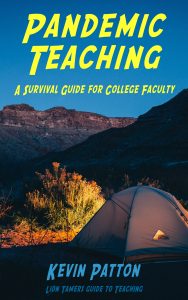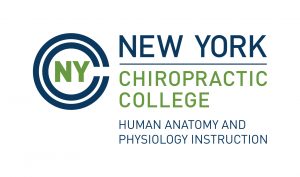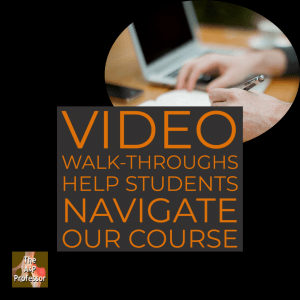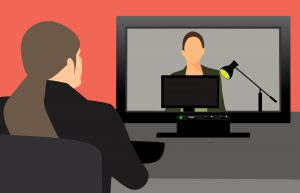Simple Ideas for Pandemic Teaching
TAPP Radio Episode 67
Episode
Episode | Quick Take
Join host Kevin Patton as he provides a simple recipe for remote teaching, reveals his new (free) eBook, explains the value of video walk-throughs, tells why he wants to be like Zoom, and gives sources for resources.
00:48 | Book Club: Pandemic Teaching
04:01 | Sponsored by AAA
04:35 | Simple Ideas for Pandemic Teaching
18:54 | Sponsored by HAPI
19:57 | Zoombombing Revisited
23:08 | Sponsored by HAPS
24:00 | Video Walk-throughs
27:37 | Pandemic Teaching Resources
28:25 | Sponsored by ADInstruments
29:43 | Staying Connected
Episode | Listen Now
Episode | Show Notes
The path of least resistance and least trouble is a mental rut already made. It requires troublesome work to undertake the alternation of old beliefs. (John Dewey)
Book Club: Pandemic Teaching
3 minutes
- Pandemic Teaching: A Survival Guide for College Faculty
- by Kevin Patton
- books2read.com/PandemicTeaching (please share this link with your teacher friends!)
- For the complete list (and more) go to theAPprofessor.org/BookClub
- Special opportunity
- Contribute YOUR book recommendation for A&P teachers!
- Be sure include your reasons for recommending it
- Any contribution used will receive a $25 gift certificate
- The best contribution is one that you have recorded in your own voice (or in a voicemail at 1-833-LION-DEN)
- Contribute YOUR book recommendation for A&P teachers!
- For the complete list (and more) go to theAPprofessor.org/BookClub
Sponsored by AAA
0.5 minutes
A searchable transcript for this episode, as well as the captioned audiogram of this episode, are sponsored by the American Association for Anatomy (AAA) at anatomy.org.
Don’t forget—HAPS members get a deep discount on AAA membership!
Simple Ideas
14.5 minutes
Kevin offers a simple formula—based on simple ideas—for us to quickly set up a remote course.
- This segment is based on a presentation given at the April 9, 2020, HAPS Town Hall Meeting.
- The video version: youtu.be/feW9Kcwhm1I
Sponsored by HAPI Online Graduate Program
1 minute
The Master of Science in Human Anatomy & Physiology Instruction—the MS-HAPI—is a graduate program for A&P teachers, especially for those who already have a graduate/professional degree. A combination of science courses (enough to qualify you to teach at the college level) and courses in contemporary instructional practice, this program helps you be your best in both on-campus and remote teaching. Kevin Patton is a faculty member in this program. Check it out!
Zoombombing Revisited
3 minutes
Zoombombing involves unwanted intrusion into our web meetings. There are ways to avoid this however!
- Check out the Zoombombing segment in the previous episode
- A Message to Our Users (Zoom’s plan for preventing Zoombombing) my-ap.us/2z7Yfw0
- Zoom: Support during the COVID-19 pandemic (Zoom’s set of resources) my-ap.us/34M8ce4
- Settings to Prevent Zoom-Bombing: How to safely host public meetings on Zoom without being interrupted by uninvited attendees. (tips from Occidental College) my-ap.us/2VfXUzU
- ‘Zoombombing’ Attacks Disrupt Classes (article discussing the importance of familiarizing yourself with the settings in your web meeting platform to avoid intrusive and offensive interruption) my-ap.us/2WGYCHH
- How to Keep the Party Crashers from Crashing Your Zoom Event (post from Zoom on how to manage settings for safety) my-ap.us/3bwesZY
- Are Zoom Chats Private? Here’s Why You Should Think Before Opening The App (Forbes article) my-ap.us/2wfqyaM
- ‘Zoom is malware’: why experts worry about the video conferencing platform (article from The Guardian) my-ap.us/2wgde62
- Bonus tools
- Web Meeting & Webinar Skills (student handout you can use or adapt for your course)
- Web Meeting-Webinar Security Tips (faculty resource for preventing unwanted disruptions)
- The two bonus tools are found only in the TAPP app
- Getting the TAPP app
- Search “The A&P Professor” in your device’s app store
- iOS devices: my-ap.us/TAPPiOS
- Android devices: my-ap.us/TAPPandroid
- Kindle Fire: amzn.to/2rR7HNG
- The TAPP app is an easy way to share this podcast
- Even folks who don’t know how to access a podcast can download an app
- Getting the TAPP app
- 5-minutes to a Great Virtual Meeting Experience (Steve Stewart’s video summarizing what he’s learned about doing web meetings. You can share this with your students, too.)
Sponsored by HAPS
1 minute
The Human Anatomy & Physiology Society (HAPS) is a sponsor of this podcast. You can help appreciate their support by clicking the link below and checking out the many resources and benefits found there. Watch for virtual town hall meetings and upcoming regional meetings!
Video Walk-throughs
3.5 minutes
Video walk-throughs—screencasts—but effective way to help students navigate their way into and through our online course platforms and other tools. Here are some tips for doing that.
- A way-past episode first introduced video walk-throughs and has additional tips: Cumulative Testing Makes Learning Last | Episode 4
- Kevin usually uses Snagit or Camtasia for his video walk-throughs. The makker, TechSmith, currently offers free access to Snagit and other software during the COVID-19 pandemic. techsmith.pxf.io/9MkPW
Pandemic Teaching Resources
1 minute
The A&P Professor website now as a page dedicated to pandemic teaching from our archives, our sponsors, and elsewhere.
Offer from ADInstruments
1.5 minutes
Episode sponsor ADInstruments is offering their Lt online learning platform with content for laboratory solutions in physiology, anatomy, and biology free at this time to help professors get ready-to-go, quality online lab experiences quickly.
🡲 Just go to Adinstruments.com/lt/covid19 to get this offer.
And tell ’em The A&P Professor podcast is where you heard about it!
If you want to check out the possibilities for your course, check out the weekly live Lt workshops at my-ap.us/LtLive
Need help accessing resources locked behind a paywall?
Check out this advice from Episode 32 to get what you need!
Episode | Captioned Audiogram
Episode | Transcript
The A&P Professor podcast (TAPP radio) episodes are made for listening, not reading. This transcript is provided for your convenience, but hey, it’s just not possible to capture the emphasis and dramatic delivery of the audio version. Or the cool theme music. Or laughs and snorts. And because it’s generated by a combo of machine and human transcription, it may not be exactly right. So I strongly recommend listening by clicking the audio player provided.
 This searchable transcript is supported by the
This searchable transcript is supported by the
American Association for Anatomy.
I'm a member—maybe you should be one, too!
Introduction
Kevin Patton:
The education philosopher John Dewey once wrote, “The path of least resistance and least trouble is a mental rut already made. It requires troublesome work to undertake the alternation of old beliefs.”
Aileen:
Welcome to The A&P Professor, a few minutes to focus on teaching human anatomy and physiology with a veteran educator and teaching mentor your host Kevin Patton.
Kevin Patton:
In this episode we have the book clubs, some simple ideas for pandemic teaching, Zoombombing revisited, video walkthroughs and lots of pandemic teaching resources.
Book Club: Pandemic Teaching
Kevin Patton:
You may have noticed that this episode did not have the usual preview episode coming out a few days ahead of time. I’m kind of experimenting with maybe getting rid of the previews. Not as many folks listen to the previews as the regular episodes and frankly I need to find more time these days to keep up with my other responsibilities. After all that 10,000 piece jigsaw puzzle is not going to put itself together. Yeah, right, like I have time for something like that. But don’t worry, we’ll still have the occasional word dissection, and of course The A&P Professor Book Club.
Kevin Patton:
Speaking of the book club you may have already heard I have a new book out called, Pandemic Teaching: A Survival Guide for College Faculty. As teaching faculty across the globe scramble to move our on-campus courses to a remote learning format, I’ve provided a quick and dirty survival guide to get things started and keep things going. Having had the experience of moving from on-campus to online teaching, I leveraged my failures and my triumphs into a quick guide to what’s important and what’s not as we make our transition in this wild and crazy time of pandemic teaching.
Kevin Patton:
The first section of the book provides a list of quick tips, strategies, and helpful mindsets, all informed by evidence based pedagogy and my own real life practical experience. The second part of the book expands on some of those quick tips to give further advice for implementing them. Written in that informal, conversational and quirky style that you’ve come to love or at least tolerate in this podcast, the Pandemic Teaching book gives useful advice and empathetic support as you survive your own experience of pandemic teaching.
Kevin Patton:
In order to download it all you have to do is go to this link, theAPprofessor.org/pandemicteaching. The book is still rolling out so more distribution channels will be added to the list that you get when you click through, so check back again if your favorite ebook store or ebook format is not yet listed. Oh yeah, I almost forgot, this is probably the most important thing. It’s free. It’s free of cost to download this book in most channels. Yep, you heard that right? No cost in most channels, and it’s only 99 cents when there is a cost.
Kevin Patton:
This book is not discipline specific, so I’m asking your help to please spread the word to your friends and other departments, your campus teaching and learning centers and contacts at other colleges, universities and teaching organizations or Facebook groups or your Twitter followers or any secret societies of professors that you might belong to. Anybody really that can use it, they can get some benefit from it. Again, the link is theAPprofessor.org/pandemic teaching.
Sponsored by AAA
Kevin Patton:
A searchable transcript and a captioned audiogram of this episode are funded by AAA, the American Association for Anatomy at anatomy.org. Did you know that if you’re looking for images to use in your remote teaching, AAA has you covered. They have a great library of image sources at anatomy.org under the resources tab. And have a snack or beverage handy because you’re going to be there for a while exploring all the resources listed there.
Simple Ideas for Pandemic Teaching
Kevin Patton:
In a recent HAPS virtual town hall meeting, I was asked to give a short presentation distilling what I’ve learned about quickly moving from on-campus to remote teaching, including some of the ideas that I’ve already shared in past episodes. Those of you who have the Tap app may have already seen and heard a re-recorded video version based on that presentation I gave in the town hall meeting. This video re-recording became available on the Tap app last week. Because it kind of draws things together and also serves as a distillation of some core ideas of my Pandemic Teaching book I thought I’d share right now a brief audio version in this segment.
Kevin Patton:
I’d like to spend a few minutes with you sharing some ideas for moving our on-campus courses quickly to a remote learning environment. Before I share my first idea, I just want to clarify that not only do I have experience in teaching on campus then moving to remote education, I also teach in a program that trains teaching faculty in ways to effectively teach both online and face to face. Because of this mentoring for at least the past eight years, I’ve been paying attention to what faculty find that works and what doesn’t work so well.
Kevin Patton:
Besides that, because I’ve been covering this developing phenomenon of pandemic teaching in my podcast, I’ve been paying close attention to what other experts are saying about the best steps we should take right now. It turns out that, and I’m as surprised as anybody about this, what the experts are saying aligns very closely with what we’ve been teaching in our faculty training program and what I’ve been sharing in my podcast.
Kevin Patton:
So I have some broad sweeping ideas, some very simple ideas for us to consider that distills what I’ve been learning. A lot of this has already been said by many of my colleagues in various venues and I’m just kind of pulling this all together. And we need to keep in mind that many of these ideas go against what our gut is telling us. They’re not only different from what we do in on-campus courses, they’re just, well, wild and crazy sounding. So I’m asking you to join me in suspending disbelief and give these ideas a chance.
Kevin Patton:
My first point is don’t just pick up your course and move the whole thing to online. My first reaction when I first started considering teaching online was to do what I do in the classroom, especially in the lecture part of the course and simply translate that into a digital format, into video. But what I found out, actually what my students found out and letting me have it with both barrels is that is boring, which means it’s hard to engage students, which means I lose some students, which means I eventually lose most students.
Kevin Patton:
All those amazing recorded lectures just well, they just sat there out in the ether not being listened to. And now I see all these teachers all over the globe doing that very thing that I found to not work very well. And what’s even more surprising, we already know that it’s not the best way to teach online and yet our campus tech people are giving us workshops on how to do that. Now I’m not saying don’t do video lectures; I’m saying don’t do the same lectures.
Kevin Patton:
The first step is starting with your learning outcomes, our course objectives. Identify only those concepts that students really must have. I mean really must be taking out of the course with them when they leave. When we do that, we have to remember that our course is not their only course or their only learning experience. They cannot and will not learn all there is for them to know about our discipline or our sub-discipline from only our course. So we need to get over ourselves and realize that our course isn’t as important as we think it is, which turns out to be a great relief when we truly embrace that idea. Wow, the pressure is off now, right? Well maybe not so fast.
Kevin Patton:
The next thing we need to do is take those core ideas and trim everything else away from all those beautiful lectures we’ve created over the course of years and then go in again and really do some trimming because it’s never enough trimming the first time and then let’s do that again and again. Keep trimming and trimming and trimming. keep going back to our material until we have, well, I’m going to go out on a limb here until we have about one third or less of what we had before.
Kevin Patton:
The next step is to chunk those lectures into pieces that are no longer than about 18 minutes because when working remotely, students are going to tune out if they’re longer. I’ve been using the analogy of being forced to leave your course home and you can only take what fits in the back of your car, not the entire contents of your course home. What’s essential? What is it that must be saved during this emergency? Just take that and nothing more. We’re heading off to teach a course in a tent, a course tent for a while, not our comfortable course home back on campus. I know that a lot of us have already tried to rebuild that entire course remotely. If that’s working for you, great. But if not, it’s not too late to go back in and start throwing things out. I think it’ll work better for you and your students when you do that.
Kevin Patton:
Which leads me to my next point, which is the world is different now. We’re assuming that if our students signed up for a class that meets on Tuesdays and Thursdays from 10:00 AM to 11:20 that we should be meeting with them on Zoom or whatever every Tuesday and Thursday from 10:00 AM to 11:20. They already had that time blocked off, right? Well, yeah, but things are not as they were. Our students may be living in a different place. Their responsibilities may have changed. There’s all these people with them who not only won’t go outside and let them concentrate, but are scrambling around trying to do their own thing. Work and family schedules have changed. I have a lot of returning learners and now they’re trying to homeschool their kids, maybe do their jobs at home during different hours than they were before. And all of us are under stress right now. A lot more stress than we probably realize consciously.
Kevin Patton:
So both we and our students need some slack here. We need to reduce their load and our load and make our course lighter than we thought our course could be. I’m thinking we should abandon regular course meetings or at least trim them way back and make them brief. Maybe just hitting the pain points and do things as asynchronously as possible, so there’s much less pressure on everyone to be dusted off and ready to go at specific times. I have found that the more I get away from my course being about me spouting off what I’ve learned and all my brilliant insights and get closer to stepping back and simply coaching and supporting students as they do their own learning, it all works way better than it ever did in the olden days.
Kevin Patton:
That supporting thing leads me to my next point, which is remote teaching is upside down and inside out. Something I’ve learned in moving from on-campus to remote teaching is that everything needs to be flipped if it’s going to work. That is the classic model of going in a classroom and lecturing two or three times a week then sending students out to learn and giving them an occasional test to see whether they did learn anything just doesn’t translate well to remote learning, which is naturally more independent and student focused then that classic model.
Kevin Patton:
What I do now is mainly about getting students started, then giving them things to do that help them learn. It may be reviewing and retrieval practice. It may be projects like case studies or even just reading assignments with reflections. There are all kinds of possibilities, but my role is to step back and just be there to help them over the humps. Once I got it out of my head that teaching has to be me pouring my knowledge into their heads, my online teaching started to become a lot more …
Kevin Patton:
That being there for them leads me to my next point, which is we need to be present to students. There is so much research out there that shows us that our connection to our students is way more effective in promoting their success and learning then all the other stuff that we do in our courses. We think it’s about all our clear explanations and wonderful media presentations, but much more of it is about how students feel connected to us and by extension connected to the ideas we’re teaching them.
Kevin Patton:
So yeah, I think we should hold back a bit on the schedule, the mandatory meetings and be more flexible, but we should also be clearly visible and available in our courses. That means we have to have a profile picture in our learning management system. We should have occasional very brief video messages to introduce a new topic or new activity or just a check in. And little things like including our photo or a video talking head in our presentations can go a long, long way in helping our students feel connected to us. But most importantly every communication we have, whether broadcast to the whole class or directed to just one student ought to be overtly supportive.
Kevin Patton:
You and I are empathetic and compassionate teachers I think otherwise we wouldn’t be drawn to conversations like this one, conversations that help us be the best that we can be for our students. But it took me a long time as a teacher to learn that students may not pick up on that unless I put some effort into actually telling them that I care and that I want to help them succeed. I always just assumed that they knew that. When I found out that they don’t automatically pick up on that and started telling them nearly every day that I love helping them get past their obstacles in learning, I saw a big change in how connected my students seemed.
Kevin Patton:
The thing is that’s hard enough to do on campus, it’s way harder in a remote learning environment. We really have to put some effort into getting that message out that we care and that we’re there for them.
Kevin Patton:
I’m going to switch gears to a little bit more practical how to suggestion. Let me suggest this simple formula for remote teaching.
Kevin Patton:
First, you probably have an assigned textbook. Whether you do or not or whether your students actually bought the book or not, doesn’t matter. Right now a lot of publishers are giving away access to them at no cost. So we and our students have this wonderful teaching and learning resource, the textbook, which is meant to be used independently at home. It’s sitting there right in front of us. As several of you listening right now can attest, a lot of work goes into making textbooks as effective for learning as they can be so let’s use them.
Kevin Patton:
Why not first take that strip down list of objectives or intended learning outcomes and construct a set or frame of distinct learning modules. Each module then has a reading assignment and an online test with randomized question sets that allow the student to take multiple attempts so that they can use them to learn the material from the reading. These are open book formative tests that allow students to work their way to mastery, unlike our usual summative tests that assume they’ve already mastered it all.
Kevin Patton:
In each module we can have a handful of recorded mini lectures that walk students through the concepts that we know from experience they’ll have trouble with. Maybe even some optional live sessions to ask questions. Period, that’s it; book, formative tests and a few short video clips or meetings, that’s all. I know it’s going to feel like you’re not doing enough, but I really believe that this simple approach is the best.
Sponsored by HAPI
Kevin Patton:
The free distribution of this podcast is sponsored by the Master of Science in Human Anatomy & Physiology instruction; the HAPI degree.
Kevin Patton:
Hey, I’m getting all kinds of feedback from our current and former happy graduate students who are out in the trenches during this time of pandemic teaching and they’re expressing their gratitude for giving them the tools, the techniques, and the flexible mindset to cope with this sudden move from on-campus teaching to remote learning. You can get this too. We have many students who already have doctorates and masters’ degrees in our program and they love it. Well, okay, maybe on some days they grumble a little bit about the desirable difficulty we challenge them with, but overall they really like it.
Kevin Patton:
Check out this online graduate program at nycc.edu/hapi. That’s HAPI, or click the link in the show notes or episode page.
Zoombombing Revisited
Kevin Patton:
In the previous episode, that is episode 66, I brought up the idea of Zoombombing, which is an unwanted intrusion into our web meetings, usually very disruptive, and often quite alarming. The name comes from the Zoom platform, which seemed particularly vulnerable to this sort of thing. And I give you some links to methods and strategies that we can use in Zoom or really in any web meeting platform to reduce the likelihood of being Zoombombed.
Kevin Patton:
I don’t have any particular relationship to Zoom other than I’m a frequent user of it. I’ve used it for podcast interviews. In fact, all the interviews you’ve heard in past episodes, they were recorded in Zoom. And I use it for my weekly meeting for a writing project I’m working on. I don’t use it for teaching though.
Kevin Patton:
But I kind of feel bad for the folks at Zoom. They were just moving along, carefully evolving a platform that seemed to be growing in popularity and then the pandemic hit and all teaching everywhere pretty much went from on-campus to remote learning practically overnight. And a lot of folks, meaning bajillions, suddenly went to Zoom for their web meetings. Can you imagine the stress on their infrastructure, the stress on their employees and the stress on the design of the tool itself? Yeah, stress on a design tends to quickly show its weaknesses and Zoom has been responding well to those weaknesses I think. They’ve already had several design changes to prevent Zoombombing and I bet more will be coming soon.
Kevin Patton:
That’s what we should all do, right? When stress reveals weaknesses in our design, maybe we should think about fixing them and moving on like the people at Zoom are doing. So I’m thinking this is one of the many lessons I’m learning during this era of pandemic teaching. That is the lesson that even the best laid plans, the most well thought out design, it can turn out to have major flaws that we weren’t seeing yet.
Kevin Patton:
So we should probably always be trying to think of unusual scenarios in which things might start to fall apart. But really when we can’t anticipate everything, so we need to stay nimble so that we can change our course quickly when weirdness does happen and reveals unexpected flaws; unexpected flaws in our course design, unexpected flaws in our teaching workflow and unexpected flaws in how we think about our teaching, how we think about our students learning and how effective all that is or not. And when that happens, heck, it has happened and will certainly happen again, I want to be like Zoom. That is, I want to be ready to fix it. I want to be willing to fix it and I want to get back on track as soon as I can.
Sponsored by HAPS
Kevin Patton:
Marketing support for this podcast is provided by HAPS, the Human Anatomy and Physiology Society, promoting excellence and the teaching of human anatomy and physiology for over 30 years. If you haven’t been stopping by for the virtual town meetings provided by HAPS, you’re missing a great opportunity to visit with other A&P teachers and learn about what they’re doing in their courses. You can just listen in, you can ask questions or you can share what’s worked for you or not worked for you. It’s really fun and uplifting.
Kevin Patton:
If you’re a member, watch your emails and if not, go visit HAPS at theAPprofessor.org/haps. That’s HAPS and join today.
Video Walk-throughs
Kevin Patton:
Video walkthroughs. I first brought this up way, way, way, way back in episode four. In the olden days when we’re all just toddlers playing together out on the playground within six feet of one another and not even wearing a mask or anything, but now’s a good time to revisit this idea I think because it’s something that’s going to help us with pandemic teaching. In this age of digital teaching and learning we need to be able to help our students navigate their digital platforms; the learning management system, adaptive learning platform, a college department or course website, just all kinds of things. And brief narrated video walkthroughs sometimes called screencasts are simple and quick ways to provide clear guidance to individuals and whole classes. I usually use Snagit or Camtasia, but there are plenty of other screen capture tools out there that I could use to record what I’m doing in my browser window as I narrate the pathways or steps that I’m taking as I take them.
Kevin Patton:
As we’re pandemic teaching, we have a lot of students that are not used to working online and certainly not in the learning management system, web meeting platforms and other online locations we’re asking them to work in. But in my experience, even those students who actually signed on for a fully online experience often have trouble getting into these platforms or performing specific tasks within them. Heck, I often have that kind of trouble myself, and it’s at those times that I really benefit from being able to call up a quick video to walk me through those steps. Of course, a key element there is the quick part of quick video.
Kevin Patton:
Something I have trouble with is making these video walkthroughs really short and to the point. I often find myself giving all kinds of options, so what else a student could do while they’re there. So what I have to do besides not being too wordy is to chop my video into discreet bite sized chunks. So yeah, I may still cover a variety of options or different kinds of things a student can do or places that they can go, but I do each one in a separate video, then put that whole list of videos in one place, like an FAQ page where they can choose which one they want or need when they need it or when they want it.
Kevin Patton:
What I often do is make them ask students ask questions. So I go ahead and record a walkthrough for that one student, but I record it in a way that’s addressed to everyone or at least addressed generically and not to that student by name. And then once that’s recorded I can go ahead and put that in my little library at the FAQ page and now it’s ready to go for anyone anytime and I can always point a student asking about that to that video. It’s already done.
Kevin Patton:
Now there’s some links in the show notes and episode page including this one from TechSmith, which is offering Snagit and other software free for teachers during this pandemic. That URL is theAPprofessor.org/techsmith. That’s T-E-C-H-S-M-I-T-H, all lower case. theAPprofessor.org/techsmith.
Pandemic Teaching Resources
Kevin Patton:
Hey, I just wanted to let you know that I created a new page at theAPprofessor.org website that collects a bunch of my resources related to pandemic teaching into one easy to browse, easy to share place. I’ve included my new Pandemic Teaching book of course, but also selected episodes of my podcast that are especially relevant to pandemic teaching; online seminars that may be helpful for pandemic teaching and a link to my daily Nuzzel newsletter so that you can stay current in what’s going on in the scientific community and in the world generally regarding this outbreak. All of this is at theAPprofessor.org/pandemicteaching.
Sponsored by ADInstruments
Kevin Patton:
Support for this episode comes from our friends at ADInstruments, who’ve come out to help support A&P teachers in our time of need. They’ve come up with a plan to let any of us use their LT online learning platform for free. As I mentioned in the last episode, LT is an online environment that you can set up very quickly and it contains ready to use content for anatomy, physiology and biology courses, even medical courses. It has over 360 interactive and fully customizable lessons and labs that are just the thing for remote learning.
Kevin Patton:
You already know that ADInstruments provides only very high quality products, and to have access to a whole set of their remote learning resources right now for free that’s an incredible thing, especially during our adventures with pandemic teaching. Just go to adinstruments.com/lt/covid19 to find out more. Once again, that’s adinstruments.com/lt/covid19. Or you can use the link in the show notes or episode page.
Staying Connected
Kevin Patton:
Don’t forget that I always put links in the show notes and at the episode page at theAPprofessor.org/67 in case you want to further explore any ideas mentioned in this podcast or if you want to visit our sponsors. And also don’t forget that I can really use your help to get the word out to all professors in any discipline about my new pandemic teaching book. If each of you shares it with just a few colleagues, it could be a best seller overnight. Wait, can it be a best seller if it’s free and not really sold? Oh, well, that doesn’t matter. I just wanted to be out there so people can get some benefit from it. Clearly I’m not doing it for a profit or fame.
Kevin Patton:
Well, okay, maybe fame. No, wait a minute. I’m an introvert, so I don’t think I want the fame thing, but I would like it if all the hard work I put into it was out there helping the maximum number of professors, so please send them this link right now while you’re thinking about it, theAPprofessor.org/pandemicteaching. That’s all lower case. theAPprofessor.org/pandemicteaching. And you’re always encouraged to call in with your questions, comments and ideas at the podcast hotline. That’s 1-833-LION-DEN or 1-833-546-6336, or send a recording or written message to podcast@theAPprofessor.org. I’ll see you down the road.
Aileen:
The A&P Professor is hosted by Dr. Kevin Patton, an award-winning professor and textbook author in human anatomy and physiology.
Kevin Patton:
Action figures are sold separately.
This podcast is sponsored by the
Human Anatomy & Physiology Society 
This podcast is sponsored by the
Master of Science in
Human Anatomy & Physiology Instruction 
Transcripts & captions supported by
The American Association for Anatomy. 
Episode support provided by


Stay Connected
The easiest way to keep up with new episodes is, um, wherever you already listen to audio!
Click here to be notified by email when new episodes become available (make sure The A&P Professor option is checked).
Call in
Record your question or share an idea and I may use it in a future podcast!
Toll-free: 1·833·LION·DEN (1·833·546·6336)
Email: podcast@theAPprofessor.org
Share

Kevin's bestselling book!
Available in paperback
Download a digital copy
Please share with your colleagues!
Kevin's bestselling book!
Available in paperback
Download a digital copy
Please share with your colleagues!
Tools & Resources
TAPP Science & Education Updates (free)
TextExpander (paste snippets)
Krisp Free Noise-Cancelling App
Snagit & Camtasia (media tools)
Rev.com ($10 off transcriptions, captions)
The A&P Professor Logo Items
(Compensation may be received)
🏅 NOTE: TAPP ed badges and certificates can be claimed until the end of 2025. After that, they remain valid, but no additional credentials can be claimed. This results from the free tier of Canvas Credentials shutting down (and lowest paid tier is far, far away from a cost-effective rate for our level of usage). For more information, visit TAPP ed at theAPprofessor.org/education
















